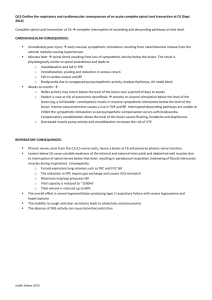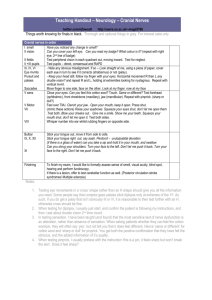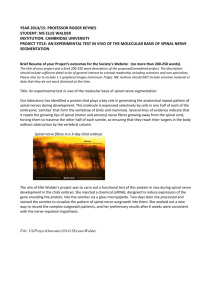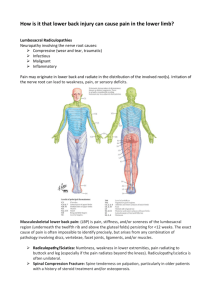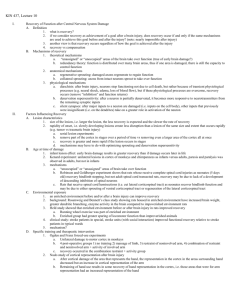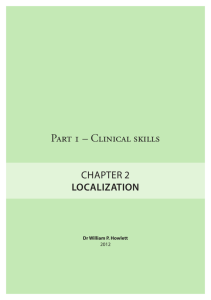Answers to margin questions (for website)
advertisement
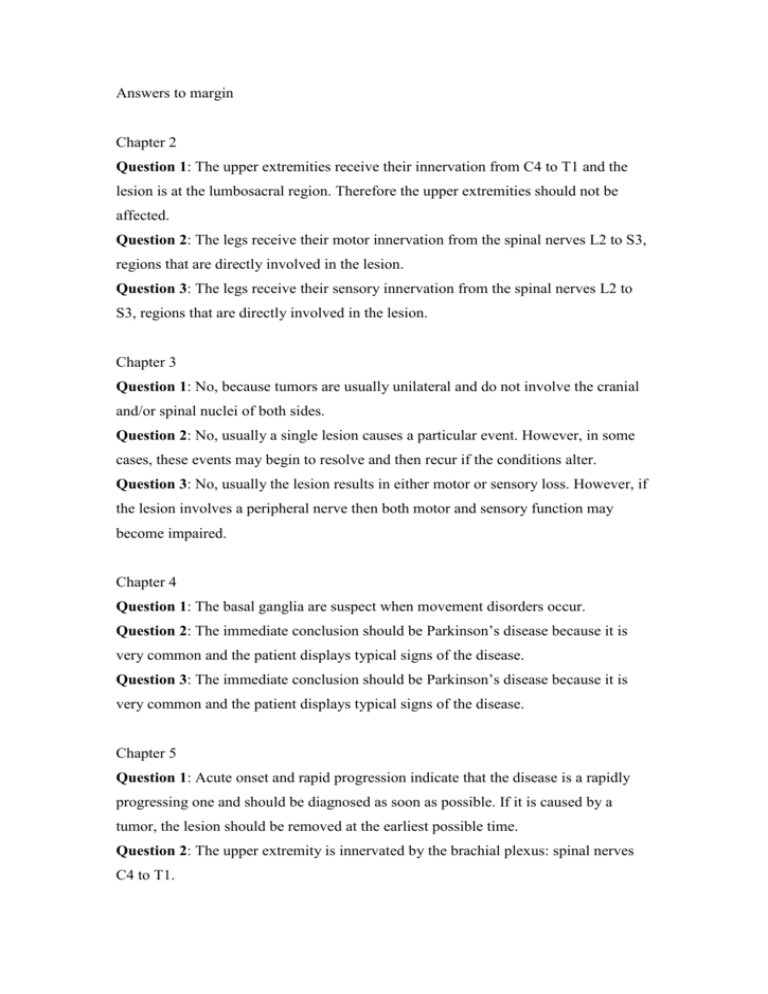
Answers to margin Chapter 2 Question 1: The upper extremities receive their innervation from C4 to T1 and the lesion is at the lumbosacral region. Therefore the upper extremities should not be affected. Question 2: The legs receive their motor innervation from the spinal nerves L2 to S3, regions that are directly involved in the lesion. Question 3: The legs receive their sensory innervation from the spinal nerves L2 to S3, regions that are directly involved in the lesion. Chapter 3 Question 1: No, because tumors are usually unilateral and do not involve the cranial and/or spinal nuclei of both sides. Question 2: No, usually a single lesion causes a particular event. However, in some cases, these events may begin to resolve and then recur if the conditions alter. Question 3: No, usually the lesion results in either motor or sensory loss. However, if the lesion involves a peripheral nerve then both motor and sensory function may become impaired. Chapter 4 Question 1: The basal ganglia are suspect when movement disorders occur. Question 2: The immediate conclusion should be Parkinson’s disease because it is very common and the patient displays typical signs of the disease. Question 3: The immediate conclusion should be Parkinson’s disease because it is very common and the patient displays typical signs of the disease. Chapter 5 Question 1: Acute onset and rapid progression indicate that the disease is a rapidly progressing one and should be diagnosed as soon as possible. If it is caused by a tumor, the lesion should be removed at the earliest possible time. Question 2: The upper extremity is innervated by the brachial plexus: spinal nerves C4 to T1. Question 3: Because lesions in the brain that affect the legs usually affect the arm and face of the same side, but almost never bilaterally. Chapter 6 Question 1: Because of the possibility of a subdural hematoma, which may be life threatening. Question 2: As his skull accelerated forward, it pushed the occipital lobe of the brain. As the skull suddenly stopped, the frontal and parietal lobes “crashed” into the skull. In addition, shearing forces at the level of the upper brainstem region can also cause damage. Question 3: No the brain does not swell in the same sense as most tissues. Since the brain is encased in a rigid skull the brain has limited confines, which it cannot overcome. However, portions of the brain can swell at the expense of other portions that may consequently become compressed. Chapter 7 Question 1: Light sensitivity alone should lead the physician to think about migraine, but when it is accompanied by fever the thinking should switch to meningitis or encephalitis. Question 2: Stiff neck accompanied by the patient’s other symptoms is indicative of meningitis and possibly encephalitis. Question 3: A resounding “yes”! At this point meningitis is suspected but it is not known whether it is viral or bacterial. Viral meningitis is usually, but not always, selflimiting, whereas bacterial meningitis can be lethal unless treated. Therefore it is always wise to assume bacterial meningitis and treat it with the appropriate antibiotics. Chapter 8 Question 1: Sudden cases of speech disorder, blindness (not involving eye damage), partial paralysis, etc., should trigger the possibility of a stroke in the physician’s mind. Question 2: Sudden cases of weakness on one side should be regarded as indicative of a possible stroke or hemorrhage. Question 3: Most strokes involve the middle cerebral artery and the symptoms of middle cerebral artery stroke include hemiparesis, hemisensory loss, aphasia, and hemineglect. The regions of the brain responsible for being alert are not affected. Chapter 9 Question 1: Salivation and the release of tears are regulated by the autonomic nervous system. Question 2: Orthostatic hypotension is the term that describes a sudden decrease of blood pressure when an individual makes a sudden move, such as standing up quickly. Question 3: Acetylcholine is the neurotransmitter at motor end-plates (skeletal muscle myoneural junctions) and postganglionic parasympathetic fiber terminations. Both lacrimal and salivary glands receive their secretomotor supply from the parasympathetic nervous system. Chapter 10 Question 1: The fasciculus gracilis and fasciculus cuneatus, bilaterally. Question 2: In the dorsal root ganglia. Question 3: In the posterior funiculus (posterior column) of the spinal cord. Question 4: Both the fasciculi gracilis and cuneatus have been affected, thus damage is extensive. Question 5: The brisk reflexes in the lower limbs indicate that peripheral neuropathy is unlikely in this patient. Question 6: This patient has a vitamin B12 deficiency that has led to the degeneration of white matter in general. The motor fibers of the corticospinal tract (which synapse with lower motoneurons in the spinal cord that directly innervate the muscles of the body) in the spinal cord will also be affected. Thus if this patient’s condition remains untreated this will lead to motor problems as well. Dementia from degeneration of the white matter in the brain and visual disturbance from optic nerve involvement may also occur if this condition remains untreated. Chapter 11 Question 1: The corticospinal tracts. Question 2: Both the upper motoneurons (of the corticospinal tracts) and the lower motoneurons located in the dorsal horn of the spinal cord (that innervate the skeletal muscles of the body) have been affected. Question 3: A contralateral hemiplegia (paralysis) of the upper and lower limbs, pathologically brisk reflexes, Babinski’s reflex. and spasticity. Question 4: Flacid paralysis, atrophy, and fasciculations in the affected skeletal muscles. Question 5: Neurologic symptoms following a stroke are of sudden onset, and head imaging in these patients will reveal changes in the brain tissue. In contrast, the patient in the clinical case described started noticing symptoms of the motor system 5 months prior to neurologic evaluation. Head imaging in patients affected by amyotrophic lateral sclerosis is usually normal. Chapter 12 Question 1: Huntington’s disease. Question 2: The caudate nucleus and putamen. Question 3: Genetic testing will confirm that this patient has Huntington’s disease. Question 4: Psychiatric disturbances and dementia. This disease causes progressive and relentless deterioration of mental function, which leads to incapacity and death 10–20 years after onset. Chorea and psychosis can be treated by antidopaminergic medication; however, there is no effective treatment for the progressive dementia. Chapter 13 Question 1: The left side since symptoms appear ipsilateral to the side of cerebellar lesion. Question 2: The vermal, inferior midline parts, and lateral hemisphere of the cerebellum. The nystagmus, vertigo, and loss of equilibrium are indicative of a lesion in the flocculonodular lobe. The dysarthria, dysmetria, and ataxia of the left arm indicate lateral hemisphere involvement. Question 3: The posterior inferior cerebellar artery. Chapter 14 Question 1: Damage of the right upper motoneurons of the corticospinal tracts caused the complete unilateral paralysis and Babinski reflex, on the left side of the body. Damage of the right upper motoneurons of the corticonuclear tract caused the slurred speech. Question 2: Normal function of the ascending reticular activating system (ARAS) is critical for the maintenance of consciousness. Lesions involving the ARAS result in coma. Respiratory difficulties and loss of all brainstem reflexes are caused by lesions to the brainstem reticular formation. This patient had a massive stroke. The above scenario is a typical progression indicative of brain herniation secondary to progressive edema from the stroke and subsequent brainstem damage. Question 3: Stretching and compression of the ipsilateral oculomotor nerve (CN III) over the tentorial notch leads to ipsilateral pupillary dilation and fixed pupil. Chapter 15 Question 1: The trigeminal nerve. Question 2: The trigeminal ganglion. Question 3: The subnucleus caudalis of the spinal nucleus of the trigeminal nerve. Question 4: The ventral posterior medial nucleus of the thalamus. Question 5: This disorder may be treated pharmacologically or surgically. Sectioning of the descending spinal trigeminal tract proximal to its termination in the subnucleus caudalis selectively obliterates the afferents relaying nociception, but spares the fibers relaying tactile sensation from the orofacial region. Chapter 16 Question 1: The converging axons of the ganglion cells of the retina. Question 2: When the ganglion cells emerge from the back of the bulb of the eye to form a bundle, the optic nerve. Question 3: The afferent limb (formed by the right optic nerve). Chapter 17 Question 1: In conduction deafness, hearing loss is caused by a defect in the mechanical transmission of sound, which interferes with sound conduction. Conduction deafness may result from wax buildup in the external auditory canal, perforation of the tympanic membrane, otitis media, or otosclerosis. Sensorineural (nerve) deafness results following a lesion involving the cochlea, the cochlear nerve, or the central auditory pathways. Question 2: The acoustic neuroma usually appears in the vicinity of the cerebellopontine angle, which compresses the vestibulocochlear nerve (associated with hearing and balance) as it emerges from the brainstem. The ataxia can arise from cerebellar dysfunction secondary to compression. Question 3: The facial nerve (CN VII). Compression of the facial nerve may cause facial numbness or weakness. Chapter 18 Question 1: The three semicircular ducts, the utricle, and the saccule. Question 2: The macula utriculi and macula sacculi, respectively. Question 3: The macula has a glycoprotein membrane (the otolithic membrane) that has on its free surface otoliths, crystals consisting of calcium carbonate. These crystals may become dislodged and float in the endolymph, causing dizziness which most often resolves on its own. Chapter 19 Question 1: The olfactory receptor cells. Their axons are susceptible to shearing as they pass into the cranial vault via the cribriform plate of the ethmoid bone, severing their connections with the overlying olfactory bulbs. Question 2: Other causes include upper respiratory infections, sinus disease, or any other nasal obstruction or congestion. Medications can induce loss of or alteration of the sense of smell. Neurodegenerative diseases, such as Alzheimer’s disease, Parkinson’s disease, or Huntington’s disease, are also associated with loss of olfactory sensation. Question 3: Recovery is rare, and there is no effective treatment. Chapter 20 Question 1: The hippocampus, located in the temporal lobe, has an exceptionally low threshold for epileptic seizures, which may be transmitted to other parts of the limbic lobe and to the neocortex. Question 2: Psychological or emotional symptoms are associated with seizures generated in the frontal or temporal lobes. The most epileptogenic regions of the brain are the temporal and frontal lobes, especially the limbic regions, which are associated with the regulation of emotional expression. Question 3: The temporal lobes exhibit medial temporal sclerosis. This appears as subtle scarring and loss of volume of the parahippocampal gyri. A loss of neurons and gliosis in the hippocampus is also evident. Chapter 21 Question 1: Orexin (hypocretin). Question 2: Fasting causes an increase in orexin synthesis by the hypothalamus. At night, hypothalamic orexin production decreases, causing an individual to fall asleep. Question 3: Individuals with narcolepsy lack the normal number of hypothalamic neurons that synthesize orexins (hypocretins), which are essential for normal sleep– wake cycle function. Chapter 22 Question 1: The ventral posterior medial (VPM) and ventral posterior lateral (VPL) nuclei of the thalamus. Question 2: The ventral and dorsal trigeminal lemnisci terminate in the VPM nucleus, whereas the spinothalamic tract and the medial lemniscus terminate in the VPL nucleus. Question 3: The patient’s blood pressure should not be abruptly lowered to “normal” levels due to the increased intracerebral pressure caused by edematous swelling of the brain following an ischemic stroke or hemorrhage. It is essential that brain perfusion is maintained, and that is accomplished by a modest reduction of the patient’s blood pressure. Chapter 23 Question 1: The left primary motor cortex strip. Question 2: Jacksonian epileptic seizures. Question 3: New-onset seizures can be caused by strokes, tumors, vascular malformations, hemorrhage, or any other lesion resulting in scar tissue formation and cortical irritation. Question 4: The temporal lobe. The hippocampus of the temporal lobe has an exceptionally low threshold for epileptic seizures, which may be transmitted to other parts of the limbic lobe and to the neocortex.

